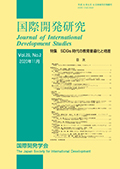Volume 29, Issue 2
Displaying 1-18 of 18 articles from this issue
- |<
- <
- 1
- >
- >|
Special Issue: Disparities and Inequalities Emerging in the Universalization of Education in the SDGs Era
-
2020Volume 29Issue 2 Pages 1-4
Published: November 20, 2020
Released on J-STAGE: December 05, 2020
Download PDF (1138K)
Articles
-
2020Volume 29Issue 2 Pages 5-20
Published: November 20, 2020
Released on J-STAGE: December 05, 2020
Download PDF (1265K) -
2020Volume 29Issue 2 Pages 21-34
Published: November 20, 2020
Released on J-STAGE: December 05, 2020
Download PDF (1284K) -
2020Volume 29Issue 2 Pages 35-47
Published: November 20, 2020
Released on J-STAGE: December 05, 2020
Download PDF (1225K) -
2020Volume 29Issue 2 Pages 49-62
Published: November 20, 2020
Released on J-STAGE: December 05, 2020
Download PDF (1249K) -
The Disparities in Educational Gap: A Case Study on Enrolment Situation in Primary Schools in Malawi2020Volume 29Issue 2 Pages 63-74
Published: November 20, 2020
Released on J-STAGE: December 05, 2020
Download PDF (1368K) -
2020Volume 29Issue 2 Pages 75-87
Published: November 20, 2020
Released on J-STAGE: December 05, 2020
Download PDF (1269K)
Note
-
2020Volume 29Issue 2 Pages 89-104
Published: November 20, 2020
Released on J-STAGE: December 05, 2020
Download PDF (1330K)
Reports
-
2020Volume 29Issue 2 Pages 105-120
Published: November 20, 2020
Released on J-STAGE: December 05, 2020
Download PDF (1283K) -
2020Volume 29Issue 2 Pages 121-132
Published: November 20, 2020
Released on J-STAGE: December 05, 2020
Download PDF (3137K) -
2020Volume 29Issue 2 Pages 133-151
Published: November 20, 2020
Released on J-STAGE: December 05, 2020
Download PDF (1945K)
Book Reviews
-
2020Volume 29Issue 2 Pages 153-156
Published: November 20, 2020
Released on J-STAGE: February 10, 2024
Download PDF (1094K) -
2020Volume 29Issue 2 Pages 157-161
Published: November 20, 2020
Released on J-STAGE: February 10, 2024
Download PDF (1096K) -
2020Volume 29Issue 2 Pages 162-166
Published: November 20, 2020
Released on J-STAGE: February 10, 2024
Download PDF (1094K) -
2020Volume 29Issue 2 Pages 167-172
Published: November 20, 2020
Released on J-STAGE: February 10, 2024
Download PDF (1100K) -
2020Volume 29Issue 2 Pages 173-176
Published: November 20, 2020
Released on J-STAGE: February 10, 2024
Download PDF (1091K) -
2020Volume 29Issue 2 Pages 177-180
Published: November 20, 2020
Released on J-STAGE: February 10, 2024
Download PDF (968K) -
2020Volume 29Issue 2 Pages 181-187
Published: November 20, 2020
Released on J-STAGE: February 10, 2024
Download PDF (1107K)
- |<
- <
- 1
- >
- >|
